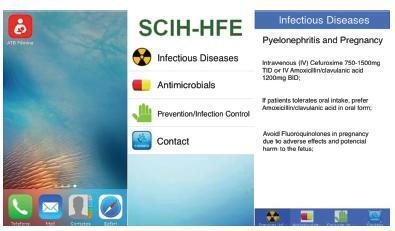Summary
Rev Bras Ginecol Obstet. 2019;41(2):68-75
To access the benefits or harms of an exercise program, based on the current American College of Obstetricians and Gynecologists guidelines, on the mode of delivery, duration and onset of labor.
A study performed at the Hospital Senhora da Oliveira between October 2015 and February 2017. This was a quasi-experimental study involving 255 women divided into two groups: an intervention group engaged in a controlled and supervised exercise program during pregnancy (n = 99), and a control group that did not participate in the exercise program (n = 156). Data were collected in two stages: during the 1st trimester biochemical screening (before the beginning of the program), through a written questionnaire, and after delivery, from the medical files of the patients. The significance level in the present study was 5% (p = 0.05).
The control group had higher odds of induced labor (odds ratio [OR] 2.71; 95% confidence interval [CI]: 1.42-5.17; p = 0.003), when compared with women who underwent the intervention. No differences were found between the groups in instrumental vaginal deliveries, cesarean rate, time until the beginning of the active phase, duration of the active phase, and duration of the second stage of labor.
The implementation of a controlled and supervised exercise program in pregnancy was associated with significantly lower odds of induced deliveries.
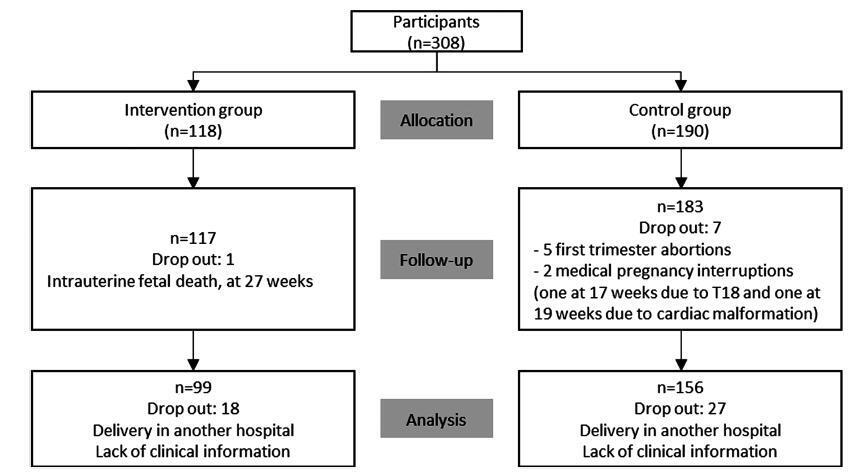
Summary
Rev Bras Ginecol Obstet. 2019;41(2):76-83
To promote informed choice for women and to compare home andhospital births in relation to the Apgar score.
Mother’s profile and Apgar score of naturally born infants (without forceps assistance) in Brazil between 2011 and 2015, in both settings-hospital or home-were collected from live birth records provided by the Informatics Department of the Unified Health System (DATASUS, in the Portuguese acronym). For the analysis, were included only data fromlow-riskdeliveries, including gestational time between 37 and 41weeks, singleton pregnancy, at least four visits of prenatal care, infants weighing between 2,500 g, and 4,000 g, mother age between 20-40 years old, and absence of congenital anomalies.
Home birth infants presented significantly higher risk of 0-5 Apgar scores, both in 1 minute (6.4% versus 3%, odds ratio [OR] = 2.2, confidence interval [CI] IC 2-2.4) and in 5 minutes (4.8% versus0.4%,OR = 11.5,CI 10.5-12.7). Another findingis related to recovery estimateswhen from an initially bad 1-minute Apgar (<6) to a subsequently better 5-minute Apgar (> 6). In this scenario, home infants had poorer recovery, Apgar scorewas persistently < 6 throughout the fifth minute in most cases (71% versus 10.7%, OR 20.4, CI 17-24.6).
The results show worse Apgar scores for babies born at home, compared with those born at the hospital setting. This is a pioneer and preliminary study that brings attention concerning differences in Apgar score related to home versus hospital place of birth in Brazil.
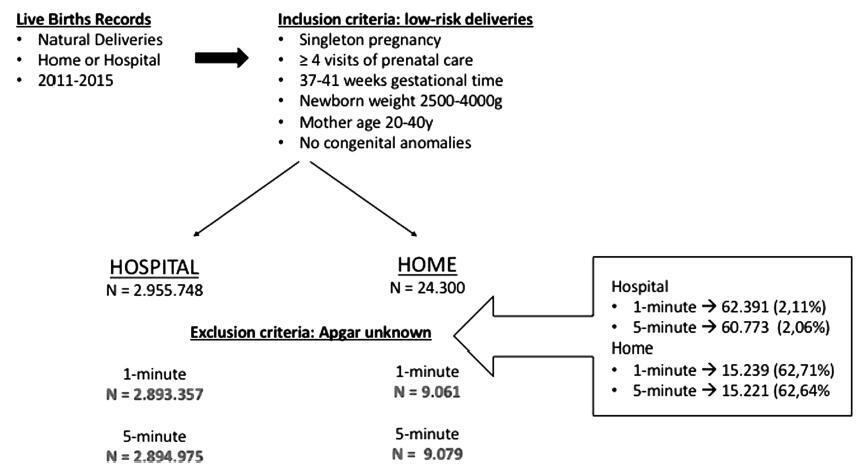
Summary
Rev Bras Ginecol Obstet. 2019;41(2):84-89
To compare low doses of pethidine with dipyrone in labor analgesia.
In a randomized prospective study conducted by Universidade de Fortaleza, in the state of Ceará, Brazil, between May and December 2016, 200 full-term parturients, with very painful uterine contractions and exhibiting uterine cervix dilatation ≥ 5 cm, were selected to receive a single intravenous dose of either 0.25 mg/kg of pethidine (n = 100) or of 25 mg/kg of dipyrone (n = 100). Pain was assessed using the visual analogue scale. The data were analyzed using the Student t-test, the chi-square test and the likelihood ratio.
There was a significant improvement in pain in 35% of the parturients. Both drugs presented a similar analgesic effect 1 hour after the intervention (p = 0.692). There was no analgesic effect during the evaluation of the second hour after the intervention with pethidine or dipyrone. There were no adverse effects, such as maternal drowsiness, nausea or vomiting, related to the drugs used.
Pethidine in low doses and dipyrone presented equivalent analgesia during labor. Public Registry of Clinical Trials.
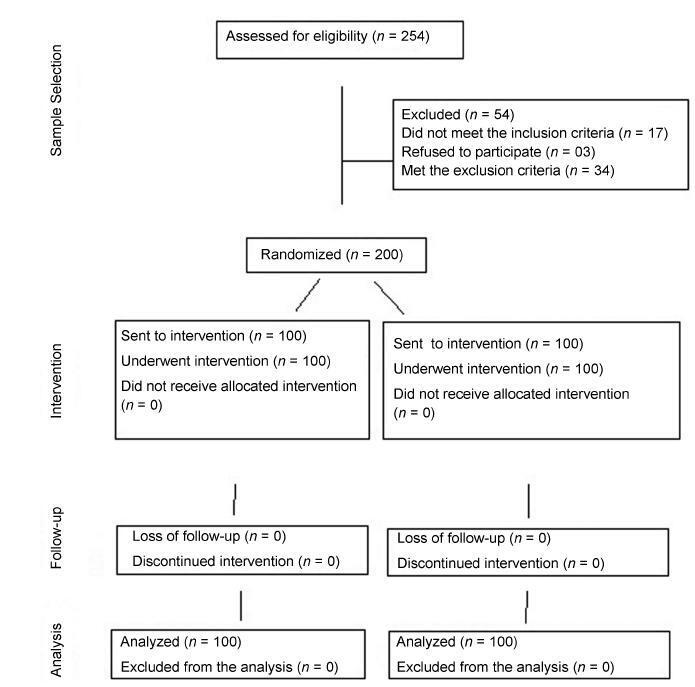
Summary
Rev Bras Ginecol Obstet. 2019;41(2):90-96
The present study assessed epidemiological and obstetrical data from pregnant women with syphilis at the Hospital de Clínicas of the Universidade Federal do Triângulo Mineiro (UFTM, in the Portuguese acronym), describing this disease during pregnancy and its vertical transmission for future healthcare actions.
Records from pregnant women who had been admitted to the Obstetrics Department of the Hospital de Clínicas of the UFTM and were diagnosed with syphilis between 2007 and 2016 were reviewed. A standardized form was used to collect epidemiological, obstetric data and outcomes of congenital infection. The present research has been authorized by the Ethics Committee of the institution.
There were 268 women diagnosed with syphilis, with an average age of 23.6 years old. The majority of the patients were from Uberaba. Inadequate prenatal care was observed in 37.9% of the pregnant women. Only 34.2% of the patients completed the treatment according to the guidelines issued by the Ministry of Health of Brazil, and 19.8% of the partners of the patients underwent adequate syphilis treatment; 37 (13.8%) couples (patients and partners) underwent correct treatment. Regarding the obstetric outcomes, 4 (1.5%) patients had a miscarriage and 8 (3.4%) had fetal losses (from the fetal loss group, 7 had no adequate treatment); 61 (25.9%) patients had premature births - this prematurity has been significantly correlated to inadequate or incomplete treatment in 49 (27.9%) patients, compared with 12 (13.0%) patients with premature births and adequate treatment (p = 0.006). The average live newborn weight was 2,840 g; 25.3% had a birth weight < 2,500 g; 74.2% had congenital syphilis, a data with heavy correlation to inadequate or incomplete prenatal care, prematurity, and low birth weight.
Public awareness policies on adequate prenatal care, intensification of serological screening, and early treatment of syphilis are needed, considering the rise of cases diagnosed during gestation and its potentially preventable deleterious consequences related to congenital transmission.
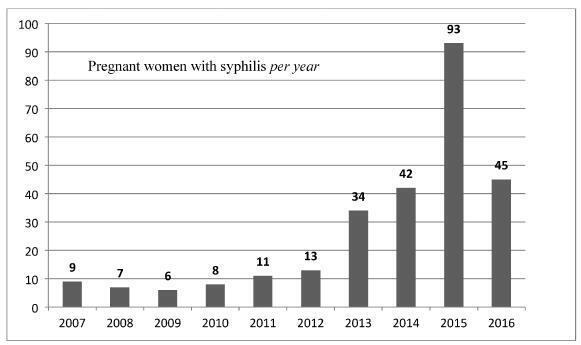
Summary
Rev Bras Ginecol Obstet. 2019;41(2):97-101
To analyze the prescription of antimicrobial agents for pregnant women admitted into the obstetrics service who presented with acute pyelonephritis.
Three cross-sectional studies were performed comparing the prescription of antimicrobials for pyelonephritis in pregnant women in the time periods evaluated (2010-2011: 99 patients evaluated; 2013: 116 patients evaluated; 2015: 107 patients evaluated), at the Hospital Fêmina, Porto Alegre, in the state of Rio Grande do Sul, Brazil. The analysis was performed before and after the promotion of an institutional protocol for the treatment of pyelonephritis during pregnancy, and on a third occasion after the introduction of a smartphone-based mobile educational tool.
The evaluation of the prescribing physicians and the adequacy of the prescriptions between the different periods studied revealed a significant increase in appropriate conduct for the choice of antimicrobial (2010: 83.8%; 2013: 95.7%; and 2015: 100%), route of administration (2010: 97%; 2013: 100%; and 2015: 100%), and interval (2010: 91.9%; 2013: 95.7%; and 2015: 100%), following the introduction of the protocol, and again after the implementation of the softwareapplicationwithorientationsontheantimicrobial treatment.
The use of specific mobile applications should be encouraged to attain a better quality and accuracy in prescriptions and to include strategies that not only reduce the risk of negative outcomes, but also improve the quality of care and treatment for maintaining the health both of the mother and of the baby.
